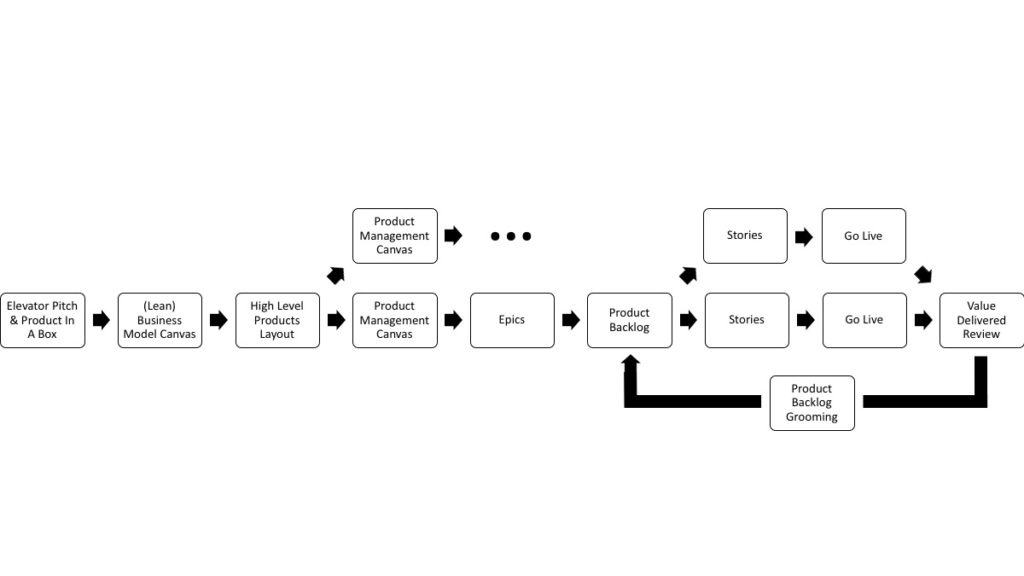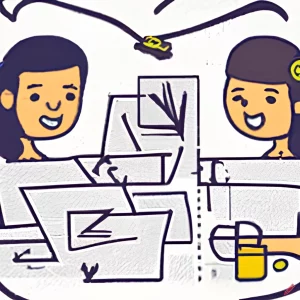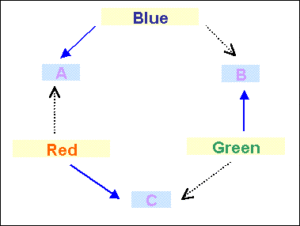I propose a method to build a Product Backlog, how to record a feature that has business value clearly quantified and how this fits into a project inception.
Introduction
Backlog Definition From Agile Alliance:
A backlog is a list of features or technical tasks which the team maintains and which, at a given moment, are known to be necessary and sufficient to complete a project or a release:
- if an item on the backlog does not contribute to the project’s goal, it should be removed;
- on the other hand, if at any time a task or feature becomes known that is considered necessary to the project, it should be added to the backlog.
These “necessary and sufficient” properties are assessed relative to the team’s state of knowledge at a particular moment; the backlog is expected to change throughout the project’s duration as the team gains knowledge.
The backlog is the primary point of entry for knowledge about requirements, and the single authoritative source defining the work to be done.
Not That Backlog
Various terms exist for a backlog being used in Agile development. Based on scope / tradition, terms Story Backlog, Feature Backlog, Epics Backlog, Development Backlog and at times Product Backlog too are used.
I will refer to these as Story Backlog so I can differentiate it with the Product backlog I am introducing in this write-up.
Story Backlog Definition From Mountain Goat Software:
The agile story backlog in Scrum is a prioritized features list, containing short descriptions of all functionality desired in the product. A typical Scrum backlog comprises the following different types of items:
- Features
- Bugs
- Technical work
- Knowledge acquisition
Story Backlog Definition From Atlassian:
A story backlog is a prioritized list of work for the development team that is derived from the roadmap and its requirements. The most important items are shown at the top of the story backlog so the team knows what to deliver first. The development team doesn’t work through the backlog at the product owner’s pace and the product owner isn’t pushing work to the development team. Instead, the development team pulls work from the story backlog as there is capacity for it, either continually (kanban) or by iteration (scrum).
Product Backlog
A Product Backlog is prioritized features list, containing short descriptions of all functionality desired in the product, with a business value for each feature clearly quantified along with source of the feature request / inspiration.
Product Backlog Card
A take at what a Product Card can look like:
| ID | |
| Theme / Module | |
| Action – Expected Result / I want to – So That / Feature / Inception time Epic | |
| Assumptions | |
| Priority | |
| Value Ranking | |
| Success Metric (to judge value delivered) | |
| Failure Metric (to trigger a re-learn / re-analyze) | |
| Status | |
| Source |
I am still not sure if Priority would still make sense given that Value Ranking is there. The reason I have added it is because Priority represents the perspective on person who is creating this card and Value Ranking is a quantitative analysis based on weightage. Value Ranking is a kind of check on the ‘gut feel’ or ’emotional’ Priority.
I think Source is important. We should link back to the CRM entry, the social media post, a market study, email, etc that lead to creation of this. It is important to refer to that original content which can be referred to as-is in future and considered as ‘interpretation free’ source which a ProMa used.
Scoping Product Backlog Card
How much work is a feature? There are some questions that a ProMa should ask to give BAs, IMs, Dev a good idea of breadth of work involved. There is, always, more to a feature than just implementation. Look at the suggested list to get an idea what I mean here:
| Time | Is a GTM time identified? |
| If yes, date? | |
| Collaterals | Does it need marketing collaterals? |
| Does it need sales collaterals? | |
| Does it need support collaterals? | |
| Does it need user collaterals? | |
| Change Management | Does it need change in process? |
| Does it need change in people & behaviour? | |
| Does it need change in how users interact? | |
| Does it need change in tech? | |
| Control | Does it bring in regulatory & legal aspect? |
| Does it bring in un-handled regulatory & legal aspect? | |
| Does it need extra/new licenses? | |
| Does it get covered by existing licensing model? | |
| Security & Safety | Does it need extra security focus? |
A yes on any of these, will affect the scope of work and for folks other than the Devs. It is important to look beyond the functionality during implementation.
Prioritizing Product Backlog
Quantifying Product Vision
A feature can be seen to provide / contribute to one or more of following values at various levels:
- BAU
- Strategic
- Competitive
- Collaborative
- Revenue
- Cost
Based on the vision, these six can be given various weightage.
Eg: 1/ A product like say ‘Am-Behind App’ is playing catch up on feature parity with competition, the weightage can be:
BAU 10% Strategic 10% Competitive 40% Collaborative 10% Revenue 20% Cost 10%
2/ A product like say ‘Am-Expensive App’ is focused on reducing capex, the weightage can be:
BAU 10% Strategic 10% Competitive 5% Collaborative 5% Revenue 20% Cost 50%
3/ A product like say ‘Want-2-Breakfree App’ is focused on growing by usual and innovative methods, the weightage can be:
BAU 25% Strategic 30% Competitive 40% Collaborative 0% Revenue 5% Cost 0%
and so on. This given a quantitative representation to your product’s vision. This should not change too often. Changes to it will change the ‘value rank’ of a feature as we will see below.
However, it is expected to change given the Build-Measure-Learn nature of ProMa. The change will drive a new priority against which the Product Backlog can be re-prioritized.
Quantifying Value
Starting with asking some key questions around these vision directions.
| BAU | Does it address key market? |
| Does it add to the USP/ Key Value Prop | |
| Strategic | Does it open up new market / opportunity? |
| Does it offer significant competitive advantage? | |
| Are early adopters identified? | |
| Competitive | Does it allow us to catch up with specific competition (eg: feature parity)? |
| Does it allow a ‘we-too-have-it’ comparison against specific competition? | |
| Collaborative | Does it help “free to use” ecosystem? |
| Does it help “paying to use” ecosystem? | |
| Cost | Does it bring cost benefit? |
| Revenue | Does it enable potential revenue uplift? |
| Does it lead to revenue uplift indirectly? | |
| Does it lead to revenue uplift directly? |
The answers can be Yes or No and quantified as 1 or 0. A Yes will lead to a value of 1 * weightage. We can add up all the values and arrive at a value rank.
Eg: For the product ‘Want-2-Breakfree App’, a feature has been requested that allows it to address a similar need but in different domain. With this vision weightage:
BAU 25% Strategic 30% Competitive 40% Collaborative 0% Revenue 5% Cost 0%
This is how feature analysis and value rank can look like:
| BAU | Does it address key market? | Yes | 25 |
| Does it add to the USP/ Key Value Prop | Yes | 25 | |
| Strategic | Does it open up new market / opportunity? | No | 0 |
| Does it offer significant competitive advantage? | Yes | 30 | |
| Are early adopters identified? | Yes | 30 | |
| Competitive | Does it allow us to catch up with specific competition (eg: feature parity)? | Yes | 40 |
| Does it allow a ‘we-too-have-it’ comparison against specific competition? | No | 0 | |
| Collaborative | Does it help “free to use” ecosystem? | No | 0 |
| Does it help “paying to use” ecosystem? | No | 0 | |
| Cost | Does it bring cost benefit? | Yes | 5 |
| Revenue | Does it enable potential revenue uplift? | No | 0 |
| Does it lead to revenue uplift indirectly? | Yes | 0 | |
| Does it lead to revenue uplift directly? | No | 0 | |
| 155 |
Now let us see for another feature. A feature has been requested that allows it to analyze the response via various marketing channels. This is how feature analysis and value rank can look like:
| BAU | Does it address key market? | Yes | 25 |
| Does it add to the USP/ Key Value Prop | Yes | 25 | |
| Strategic | Does it open up new market / opportunity? | Yes | 30 |
| Does it offer significant competitive advantage? | Yes | 30 | |
| Are early adopters identified? | Yes | 30 | |
| Competitive | Does it allow us to catch up with specific competition (eg: feature parity)? | Yes | 40 |
| Does it allow a ‘we-too-have-it’ comparison against specific competition? | No | 0 | |
| Collaborative | Does it help “free to use” ecosystem? | No | 0 |
| Does it help “paying to use” ecosystem? | No | 0 | |
| Cost | Does it bring cost benefit? | Yes | 5 |
| Revenue | Does it enable potential revenue uplift? | Yes | 0 |
| Does it lead to revenue uplift indirectly? | Yes | 0 | |
| Does it lead to revenue uplift directly? | No | 0 | |
| 185 |
So, the later feature should be prioritized higher in the Product Backlog.
Product Backlog and Inceptions
How does a Product Backlog fit into our Inception? Here is my earlier blog post on this: Product Management During Project Inception
Summary:

Never Alone
This started with a lunch time discussion with Sriram Narayan few months back. It got re-triggered by a question by Kartik Kannan “How do ProMa figure in Inception Process?” Thanks to Priyanka Kapur and Anantpal Singh Saluja who became first user of this method while creating a pitch for a client.




Very useful